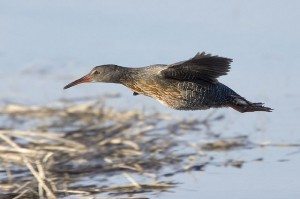Farewell Clapper Rail, hello Ridgway’s Rail
By Dave Quady
Like many other birders, I always look forward to the July issue of The Auk, the journal of the American Ornithologists’ Union (AOU). Why? Because it contains the annual supplement to the AOU’s bird checklist, which governs the taxonomy followed by North American birders.
The run-up to publication usually includes speculation about changes the supplement will bring: will they be minor (“Oh, a few species lost the hyphens in their names”), or taxonomy-rattling (“What? Falcons were put behind the woodpeckers?”). Rumors precede publication, of course, so the supplement’s content is rarely a surprise. But no change is official until it’s published.
This year’s supplement affected the family Rallidae – the rails, marsh-loving birds that some people are said to be thinner than. Clapper Rail Rallus longirostris, a bird of mainly coastal marshes, was split into three species, and King Rail Rallus elegans of the eastern U.S. was split into two.
California’s three subspecies of Rallus longirostris become subspecies of Rallus obsoletus, which is given the English name Ridgway’s Rail. It has three resident subspecies: yumanensis (in the lower Colorado River area), levipes (in coastal southern California), and nominate obsoletus, (in coastal marshes of the San Francisco Bay area).



All three subspecies are on the Federal endangered species list; two are also on the state endangered species list (SE) while the third is state threatened (ST). The split will not change their conservation status, but authorities will probably come up with new English names for the subspecies.
Subspecies yumanensis (ST) was called “Yuma Clapper Rail.” Modifying it to “Yuma Ridgway’s Rail” seems awkward, but could work. Something similar could be done with levipes (SE), formerly called “Light-footed Clapper Rail.” But how about our local obsoletus, formerly called “California Clapper Rail?” One wouldn’t want to call it “California Ridgway (formerly Clapper) Rail,” for sure, and “Ridgway’s California Rail” isn’t much better. A good English name doesn’t immediately come to mind.
In the aftermath of the Clapper Rail split, that English name was transferred to a species with another scientific name. Thus, Clapper Rail is now the English name for Rallus crepitans, and birders who have seen it in east coast saltwater marshes got a new life bird as they read the news – assuming they’d already recorded what’s now called Ridgway’s Rail.
And what about the poor old scientific name Rallus longirostris, which just lost its former English name, Clapper Rail? The AOU named it Mangrove Rail, for its favored habitat in coastal South America, outside the AOU area.
To conclude the story of this year’s rail splits, the King Rail Rallus elegans of the eastern U.S. was also split. The former English and scientific names continue to apply to subspecies resident in the eastern U.S. and in the Caribbean, but subspecies resident in Mexico’s interior freshwater marshes are split as Aztec Rail Rallus tenuirostris.
It’s worthwhile to muse about the difficulties of choosing new English names when a species is split. Many believe it’s best to apply new names when a species is split, and indeed it is the AOU’s policy to do so. When that’s done, the former name in time slips away from common use, and if it appears in print the reader assumes that it refers collectively – if imprecisely – to both of the two split species. A good example is Plain Titmouse, which the AOU split in 1996 into Oak Titmouse and Juniper Titmouse.
Contrast that case with this year’s splits: if you see the term Clapper Rail, or King Rail, in print ten years from now, how will you know what’s being referred to – one or more of the subspecies included within that name up until July 2014, or only the subspecies that are included within Clapper Rail, or King Rail, after the split?


Going back to 1996’s Plain Titmouse split, note how handy it was that the two new species displayed distinct differences in preferred habitat (as well as in song and genetic makeup) that were well summarized by the terms Oak and Juniper.
Now consider the challenge faced by last year’s Sage Sparrow split. Both of the splits prefer habitat that’s often – if loosely and imprecisely – called sage. So . . . what to call them? Well, before the name Sage Sparrow came into use, the species was known as Bell’s (or the Bell) Sparrow, named by John Cassin to honor John G. Bell, a mid-19th century collector who provided him the type specimen. Happily (in my opinion) the AOU reverted to the English name Bell’s Sparrow for the nominate “half” of the split whose scientific name is Artemisiospiza belli. And Joe Morlan suggested a fine English name for the other “half”: Sagebrush Sparrow, a name that describes its preferred habitat well – and differs from its pre-split name.
I like honorific names such as Bell and belli. But the honorific game can be tough, as it was in 2012. Xantus’s Murrelet (honoring John Xantus, the mid-19th century naturalist who described the species) was split into Guadalupe Murrelet (named for the species’ nesting islands) and Scripps’s Murrelet (honoring Robert P. Scripps, who had provided the yacht used on the expedition that collected the type specimen). On that split, Xantus lost a murrelet and Scripps earned one.
So, who was Ridgway, and why did he earn a rail? Robert Ridgway was a giant of late 19th and early 20th century American ornithology. He worked at the Smithsonian Institution for 55 years, 43 of them as Curator of Birds. He was also a founding member of the AOU and later its president, and during his lifetime he described more new taxa of American birds than anyone else, among them the nominate subspecies of the rail that now bears his name. Ridgway’s taxonomic judgments overall have stood the test of time so well that some modern ornithologists still say, only half-jokingly, that rule #1 is: Ridgway was right.
* * * * *
Now that this year’s checklist supplement is out, it’s time (Ta – daa!) to speculate about what splits next year might bring. There are rumors that Western Scrub-Jay and White-breasted Nuthatch will be split, once a bit more laboratory and/or field work is completed and published. Will either, or both, be split next year? If so, into how many species? And what names will they bear?
Make your picks and put your money down; next year’s naming game has begun.
————————————————-
